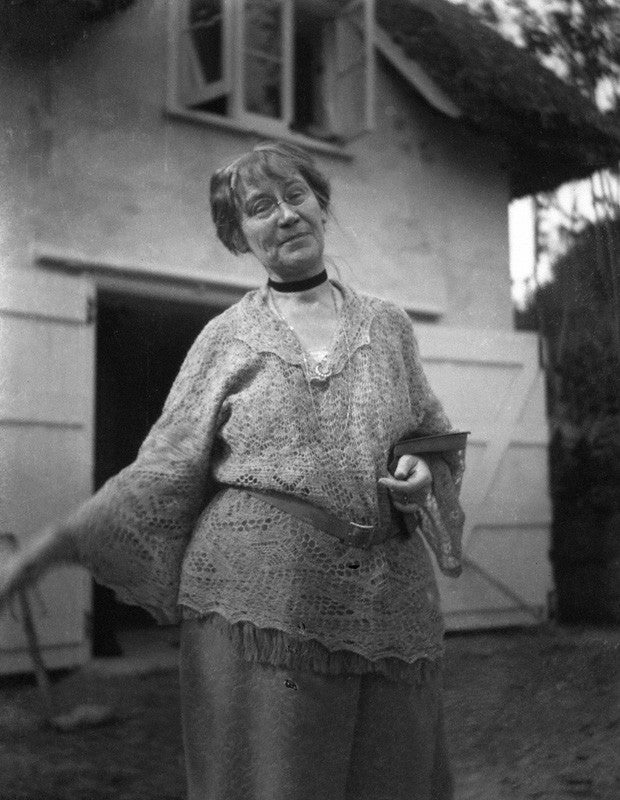Dorothy Bussy’s novel Olivia rarely makes it onto recommendation lists. In fact, despite the success of the eponymous lesbian-oriented Olivia Travel (originally Olivia Records), few contemporary readers know much about it. However, André Aciman, author of the coming-of-age novel Call Me by Your Name, considers Olivia the spiritual ancestor to his own modern explorations of young, struggling queer love. As he wrote in the introduction to the 2020 edition of Olivia,
It [Olivia] retains that unmistakable classical, thoughtful, and wise-to-the-world vein that is almost courtly in its depiction of how desire, arousal, and love can swell between individuals who are unwilling to speak their love or unable to abandon themselves to what each knows the other craves.
Like her novel, Dorothy Bussy née Strachey (1865–1960) was a woman who existed on the margins. As the sister of successful biographer Lytton Strachey, she associated with the bohemian Bloomsbury group in the early twentieth century, but she was never fully integrated into it. Married to painter Simon Bussy, she identified as bisexual and had love affairs with both men and women, yet she never achieved the notoriety of other promiscuous artists of the age. And, like the rest of her family and social circle, she dabbled in writing. One fruit of her experimental labors was an autobiographical novel that depicts her thinly disguised coming-of-age experience of falling in love with a teacher while studying at an all-girls boarding school in France. This was Olivia, first published in 1949 by the Hogarth Press. Run by entrepreneurial couple, Virginia and Leonard Woolf, Hogarth Press dared to publish anything, even if it invited scandal.
An older woman reminiscing on her troubled romantic past, the narrator, Olivia, offers readers a tour through her life as a precocious sixteen-year-old experiencing both intellectual and sexual awakenings as her attractive and cultured instructor, Mademoiselle Julie, takes her under her wing. Infatuation and first love ensues. As Bussy writes in the opening pages of the novel,
This account of what happens to me during a year that I spent at school in France seems to me to fall into the shape of a story—a short, simple one, with two or three character and a very few episodes. It is informed with a single motive, tends to a single end, moves quickly and undeviatingly to a final catastrophe.
But Olivia is anything but simple, as complications and intrigues that arise throughout the novel lay siege to what remains of the main character’s innocence and peace of mind. Aciman aptly describes the book as a “roman d’analyse”: a psychological novel.

Bussy herself had wavering confidence in the work and hesitated to have it published. This wasn’t helped by the cool reception she received when she sent it to her close friend (and fellow writer) André Gide for feedback. He read it once and forgot about it.
“Olivia lay fifteen years in Gide’s desk drawer before it managed through Leonard Woolf’s kind offices to reach the public,” remarks Richard Tedeschi in his study of the Gide-Bussy letters.
Perhaps, as an adult male author, Gide failed to relate to the story, which dealt with the sexual maturation of a young woman. But once brought forth by Hogarth Press, which had by then merged with Chatto & Windus, the novel’s success “in England, France, and America became a source of satisfaction to its author, of funds badly needed by the Bussy family, and a series of amusing letters,” writes Tedeschi. Describing Woolf’s enthusiasm for her story, Bussy teases Gide about his poor publishing decisions (while editor of the Nouvelle Revue Française, he had rejected Du Coté de chez Swann [Swann’s Way]).
Weekly Newsletter
“While we may be grateful that the full range of the work and the generally ambisexual nature of these artful notables are finally being brought into view, the Bloomsbury corpus is to date uneven,” writes Blanche Wiesen Cook, who includes an analysis of Olivia in her study of lesbian literature.
Considering the quality of her sensuous, poetic writing style, and the fortitude with which she approached the taboo subject of blossoming female sexuality, it’s unfortunate that Bussy’s writing career never quite took off, and that she wrote no known works other than Olivia. However, as proven episodically by literary history, some authors only have one great novel in them. Olivia is a worthwhile contribution to LGBT fiction, an engaging read for anyone who remembers the awkwardness and turmoil of one’s adolescent years and, like Bussy, is willing to put forth the effort to make sense of it.
Support JSTOR Daily! Join our new membership program on Patreon today.







